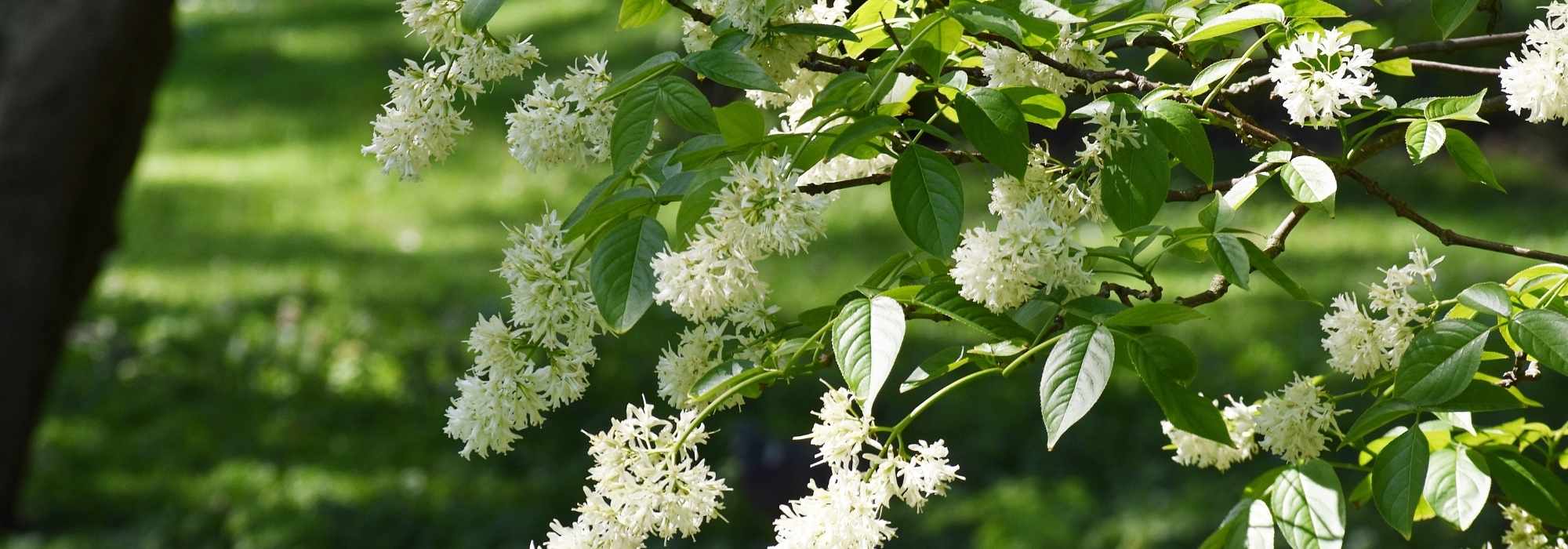
Staphylea - Bladder nut: planting and growing
Contents
Staphylea in a few words
- The Staphylea is a large bush, remarkable for its flowering and fruiting.
- The spring flowering is abundant and highly fragrant.
- Staphyleas should be planted in full sun or partial shade in any soil that remains moist.
- The Staphylea is an easy-to-grow and very hardy bush.
- The fruiting of Staphyleas is edible, somewhat similar to pistachios.
The word from our expert
It’s always sad when a plant isn’t appreciated at its true worth. And in my opinion, this is the case with Staphyleas or False Pistachios. Although Staphylea pinnata is more commonly planted in the northeast of France, these bushes are rarely seen in gardens and nurseries. Yet, they are remarkable large bushes in more ways than one.
Their particularly generous spring flowering, with pendulous panicles of creamy-white, delights the eye and also the nose thanks to their fragrance blending orange blossom, almond, and coconut. The deciduous foliage, divided into several leaflets, is green and then yellow in autumn, but there are cultivars with very dark, almost black foliage (Staphylea colchica ‘Black Beauty’). The fruiting, in small inflated lanterns, is exceptional, as it remains beautiful from autumn until winter, when the foliage has fallen, but also because the seed contained in the capsule is edible, roasted like pistachios.
With excellent hardiness, Staphyleas thrive in sun or partial shade in a wide range of soils, provided they are cool but well-drained. False Pistachios clearly deserve a small spot in every garden, as a standalone, in hedges, at the back of borders, in groves, or even in pots. What are we waiting for? Let’s plant a Staphylea!
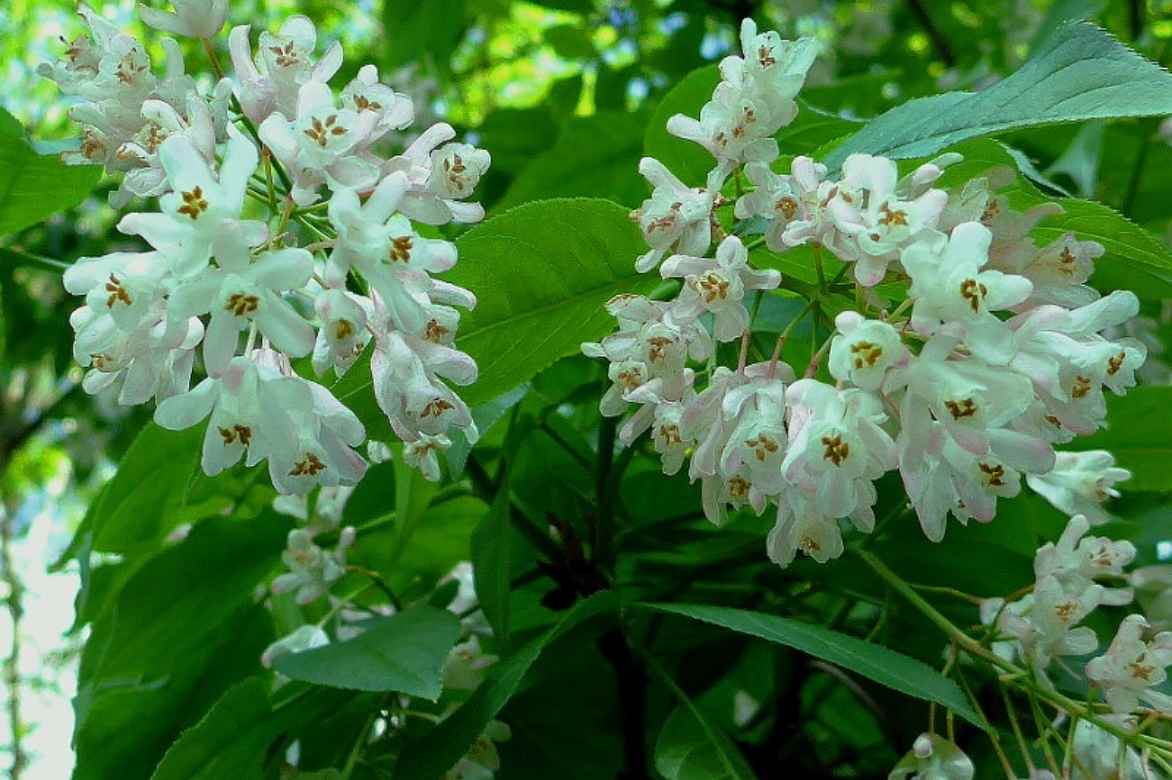
Staphylea colchica (© Delirium florens)
Botany and description
Botanical data
- Latin name Staphylea sp.
- Family Staphyleaceae
- Common name False Pistachio, Cut-nose, Rosary Bush
- Flowering April to May
- Height 4 m maximum
- Exposure sun, partial shade
- Soil type deep, fertile and moist
- Hardiness -15°C
The genus Staphylea includes about ten species of trees, shrubs or bushes found in the humid undergrowth of the northern hemisphere. Staphyleas belong to the Staphyleaceae family.
Among these species, you will find Staphylea x elegans, Staphylea holocarpa, Staphylea bumalda, Staphylea bolanderi, but the three most well-known and cultivated species are: Staphylea pinnata (native to Central Europe as far as Alsace and the Jura), Staphylea trifolia (native to the eastern United States), and Staphylea colchica (native to the Caucasus).
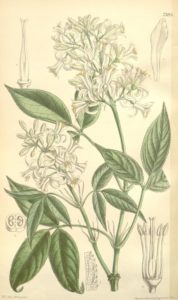
Staphylea colchica botanical plate
The genus name “Staphylea” comes from the Greek “staphyl,” meaning “bunch of grapes,” referring to the cluster-like shape of the inflorescences. Staphyleas are characterised by opposite, compound leaves with 3 to 7 leaflets, as well as white or pink paniculate flowering and an original, persistent fruiting that lasts all winter.
Staphyleas generally have a slender, well-branched silhouette, reaching 3 to 4 m in height (slightly more for Staphylea trifolia). Growth is rapid. The bark is initially smooth, grey-green in colour, lightly streaked with white and dotted with lenticels, but over time, it cracks and ages beautifully. Staphyleas benefit from being pruned to allow some of the bark to show through.
The foliage is deciduous, glossy green in colour, turning yellow in autumn before falling. The leaves are opposite and divided into 3 leaflets in Staphylea trifolia (Three-leaf Staphylea) or 5 leaflets in Staphylea colchica (Colchis Staphylea) and Staphylea pinnata (Pinnate Staphylea). Each leaflet, ovate and acuminate, is delicately and finely toothed. The compound leaf is attached by a petiole surrounded by small bracts. Some cultivars feature very dark foliage, almost black, like the Staphylea colchica ‘Black Beauty’ or changing, like the Staphylea colchica ‘Black Jack’, whose foliage transitions from green to deep red and finally orange in autumn.
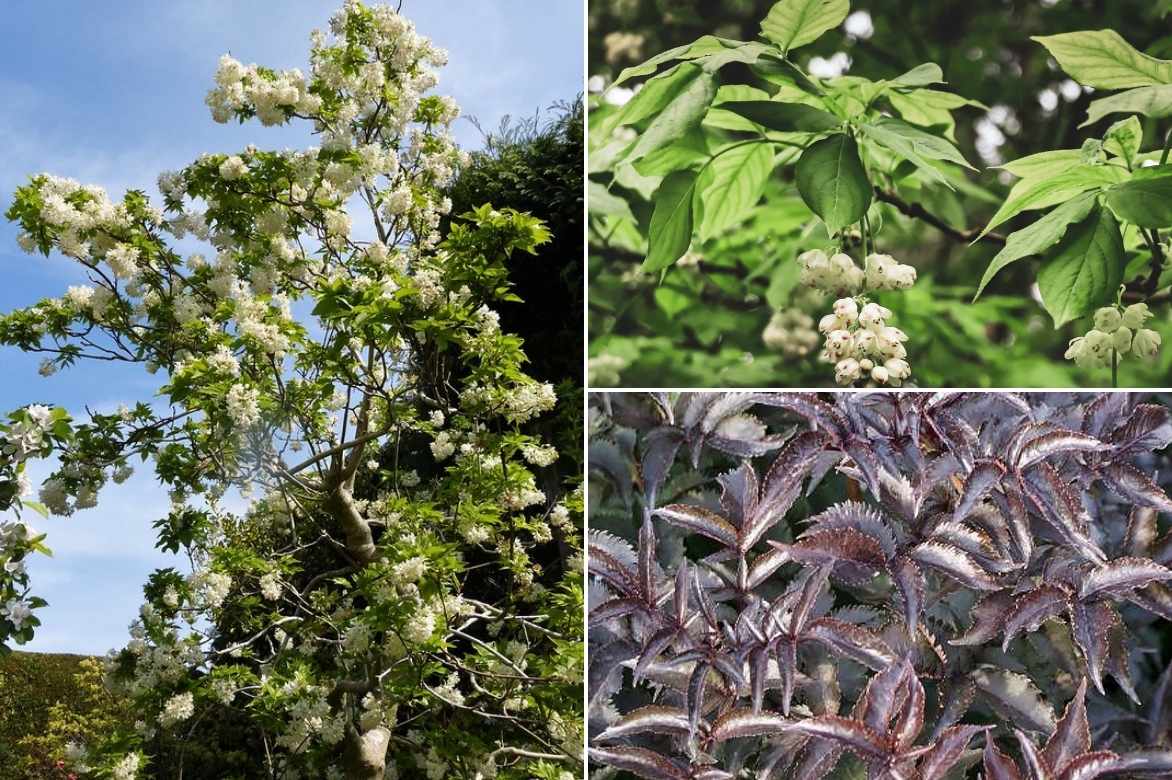
Left, Staphylea trifolia (© gailhampshire), top right Staphylea pinnata, and bottom right Staphylea colchica ‘Black Beauty’
Flowering occurs in spring between April and May. It consists of clusters (racemes) of small white bell-shaped flowers (like campanulas), hanging from long peduncles. The flowers are nectariferous and melliferous, emitting a fragrance that blends coconut, almond, and orange blossom. Note that there is a pink-flowered Staphylea: Staphylea holocarpa var. rosea (though good luck finding it in the trade!).
Fruiting is unique in false pistachios. They produce vesicular, trigonous capsules tapering to a point. The colour of these capsules changes from pinkish-beige to greenish, eventually turning rusty in winter. The fruits ripen between September and October and remain on the bush for a long time, even after the leaves have fallen. Each capsule contains 1 to 4 seeds, edible once roasted, similar to pistachios.
Note: Staphylea pinnata has been protected in Alsace since 1993, where it is considered a native species.
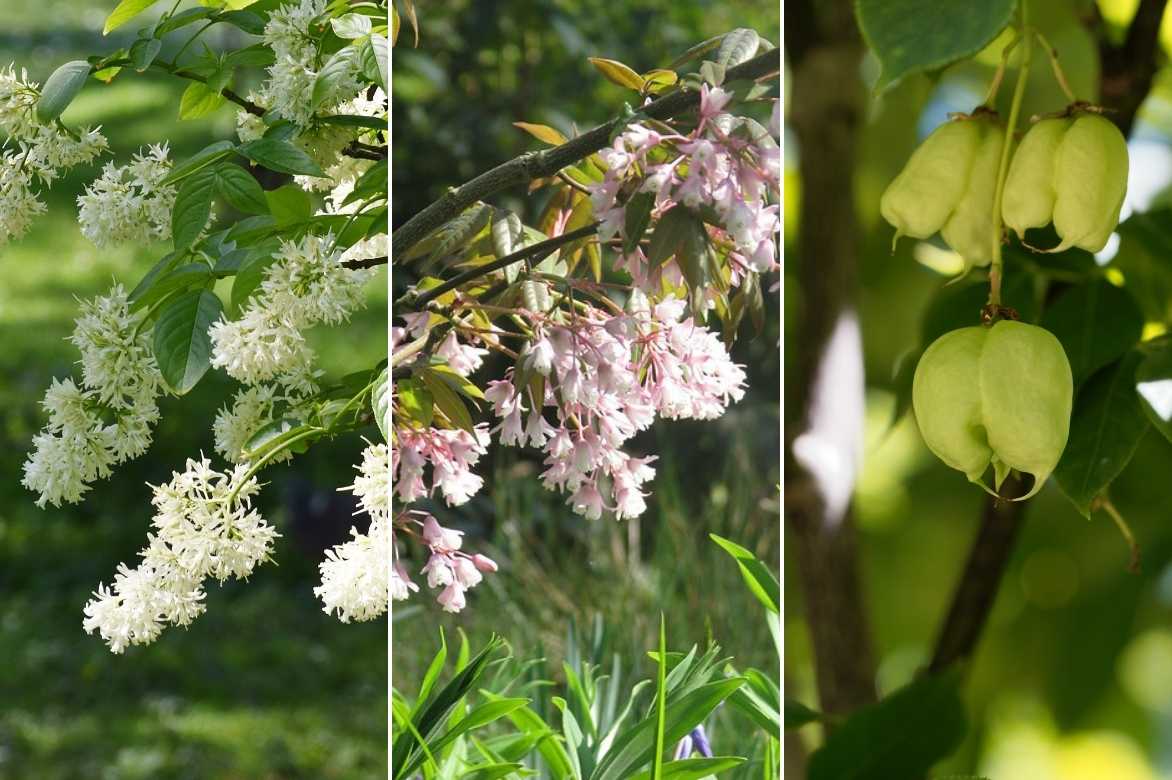
Staphylea colchica, Staphylea holocarpa ‘Rosea’, and fruiting of Staphylea pinnata
Our most beautiful varieties

Staphylea colchica
- Flowering time May, June
- Height at maturity 3 m
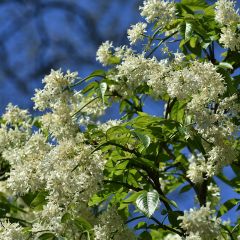
Staphylea colchica Black Jack
- Flowering time May, June
- Height at maturity 3,50 m
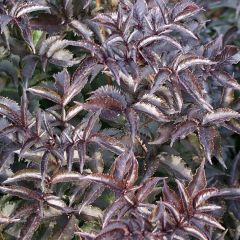
Staphylea colchica Black Beauty
- Flowering time May, June
- Height at maturity 3,25 m
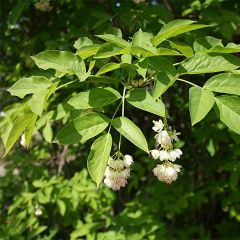
Staphylea pinnata
- Flowering time June
- Height at maturity 4 m
Discover other Staphylea
View all →Available in 1 sizes

Available in 2 sizes
Available in 2 sizes
Available in 1 sizes
Planting Staphylea
Where to Plant?
Staphyleas should be planted in full sun or partial shade.
The soil should be deep, fertile, and remain moist but well-drained. Although they prefer acidic to neutral soils, they can tolerate slightly alkaline soil, especially in the case of Staphylea pinnata.
Staphyleas thrive in long, hot summers, which help them produce a more abundant flowering the following spring.
When to Plant?
Staphyleas can be planted either in spring (March-April) or autumn (October-November). We recommend planting in autumn: the bush will have ample time to take advantage of moist soil to establish a strong root system before the summer droughts of the following year.
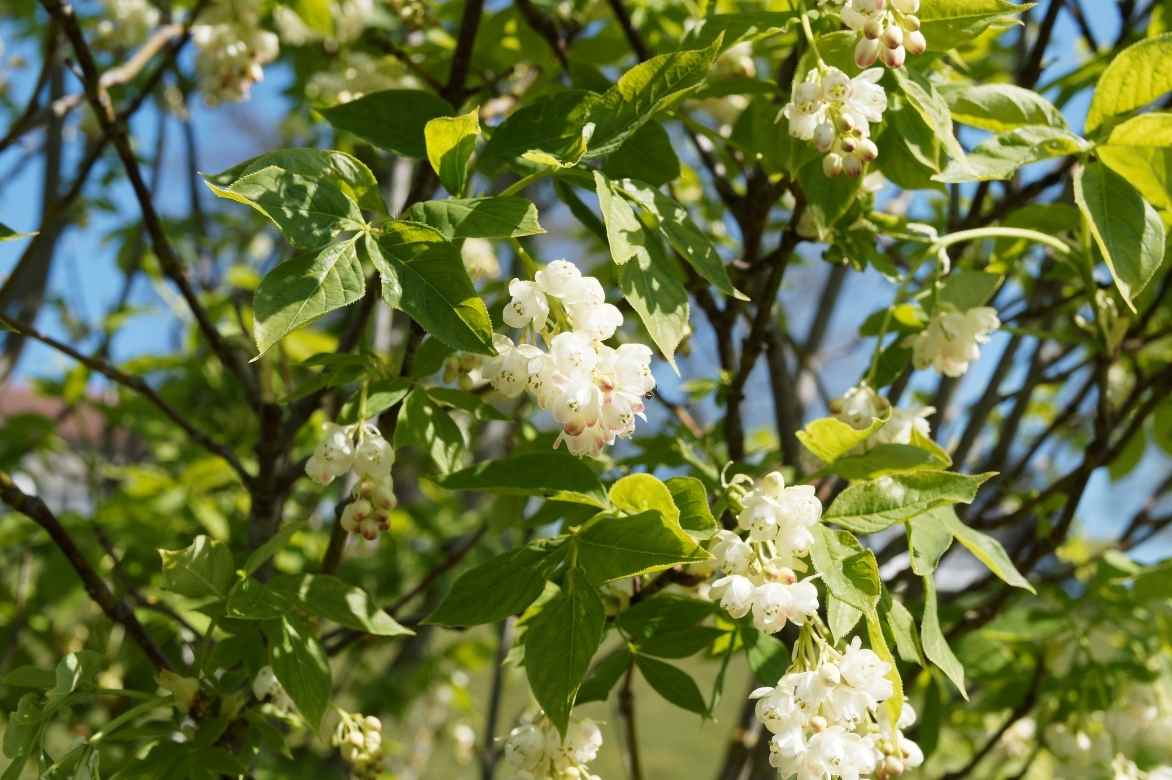
Staphylea pinnata in flower
How to Plant?
In the Ground
- Soak your pot in a basin of water for a few minutes to rehydrate the root ball;
- Remove it from the pot, check the roots, and gently loosen part of the root ball to free them;
- Dig a hole twice as deep and wide as the root system of your bush;
- Loosen the soil at the bottom of the hole and add some well-rotted manure or dried blood and ground horn;
- If your soil is heavy (clayey and compact), mix gravel with the excavated soil: this will improve water drainage in winter;
- Place your bush in the hole, spreading the roots evenly;
- Fill the hole with the excavated soil (with or without gravel). Do not bury the collar!;
- Firm the soil around the base of the Staphylea with your hands;
- Water thoroughly. The weight of the water will help eliminate air pockets between the roots and the soil;
- You can mulch the surface to retain soil moisture or plant some ground-cover perennials directly.
In a Pot
Staphylea can be grown in a pot if you choose a sufficiently large one: at least 50 cm wide and deep. The pot must have drainage holes for water to escape. Place a layer of gravel or clay pebbles at the bottom of the pot to improve drainage. The substrate should be rich: a mix of 50% good garden soil and 50% high-quality universal compost will be perfect. Water well after planting and remember to water during dry spells.
Pruning and Maintenance
Watering
For the first two years after planting, remember to water at the base during dry spells. After that, the bush should withstand drought without any issues. However, in pots, a good watering should be provided as soon as the substrate dries on the surface.
Don’t forget to mulch or plant ground cover plants around the base of your Staphylea to keep the soil cool.
Pruning
Pruning is optional: simply remove dead wood, overly thin or poorly placed branches. Over the years, the Staphylea will benefit from being thinned to give it the appearance of a small tree and reveal its beautiful bark. Prune at the end of winter (March) before the foliage appears.
If pruning is really necessary to control its growth, you can also prune after flowering, in June. However, you will lose its beautiful fruiting.
Maintenance
In poor soil, you can add a bit of well-rotted compost around the base of the bush before winter or in spring when planted in the ground. In pots, use a liquid fertiliser for flowering plants once a month from spring to the end of summer.
Possible diseases and pests
No need to worry with the False Pistachio. These bushes are highly resistant to diseases and parasitic pests.
Propagation of the False Pistachio
Propagation by Cuttings
The heel cutting method works best. You have a choice of timing: in spring (herbaceous cutting), in summer (semi-hardwood cutting), or in winter (hardwood cutting).
→ To learn all about the different types of cuttings, read Alexandra’s advice.
Sowing
The seeds are harvested in autumn. Place them in a well-draining substrate (such as seed compost) in a pot in the shade under a cold frame. Leave your pot outside in winter so the cold can stratify the seed. Patience is sometimes required, as staphyleas seeds may only germinate a year later.
Alternatively, the False Pistachio readily self-seeds in the garden if conditions are favourable. Feel free to move the young seedlings in autumn.
Recovering Suckers
Similarly, the Staphylea occasionally produces suckers. Simply separate a sucker from the parent plant and replant it elsewhere in spring or autumn.
Layering
It is possible to layer the lower branches of a Staphylea. Bend and secure a flexible branch to the ground. This will produce roots. You can then sever, i.e., separate the layer from the parent plant after two years of growth.
How to pair Staphylea?
The Staphylea pinnata will blend perfectly into a beautiful wild hedge alongside elderberries, hawthorns, rowans, medlars, guelder roses, serviceberries… as well as more colourful bushes in spring such as lilacs, roses (especially the botanical ones), and spring spireas…
The Staphylea colchica ‘Black Beauty’, with its very dark foliage, will work wonders alongside trees and bushes with lighter, even golden foliage. For example, you could plant a Cercis canadensis ‘Eternal Flame’, with yellow, orange, and red foliage in spring and autumn, and light green in summer, alongside a Cornus alba ‘Aurea’, with golden yellow foliage for much of the year. At the base of the bladdernut, consider two types of creeping perennials: one with almost black foliage to echo that of the False Pistachio, such as a creeping bugle ‘Black Scallop’, and the second, in contrast, with yellow foliage, such as a Brunnera macrophylla ‘Green Gold’.
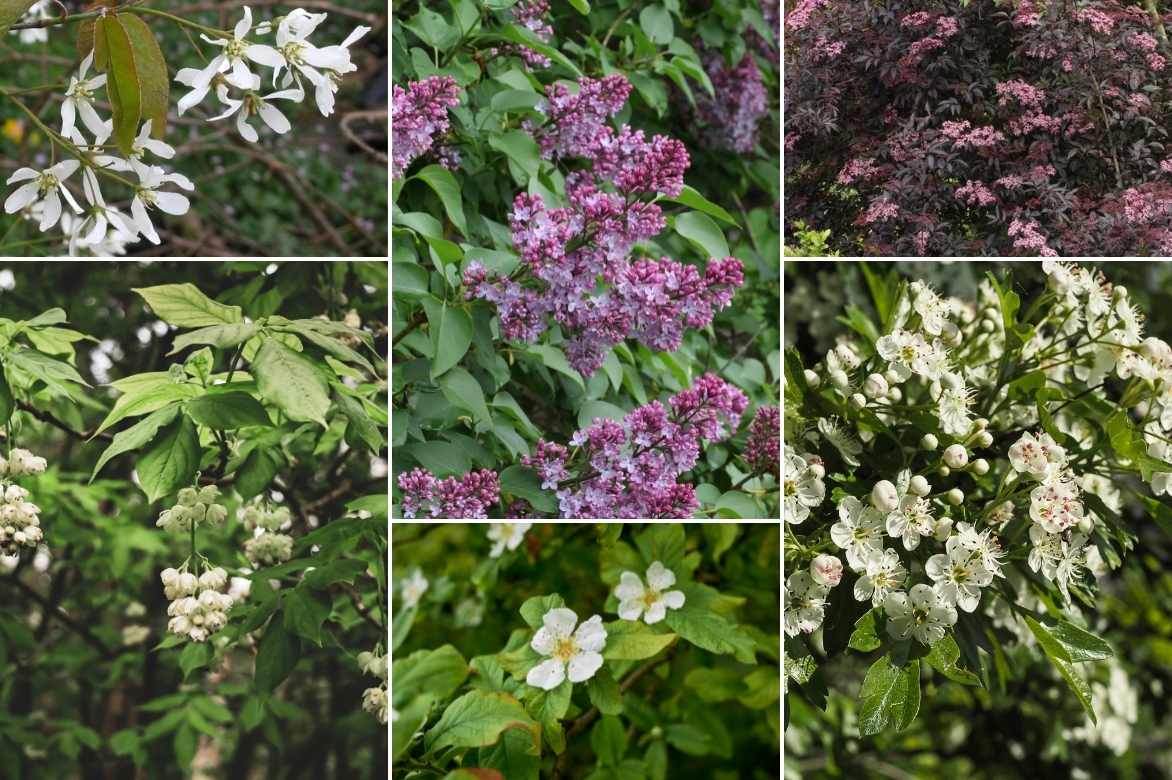
Bottom right, a Staphylea pinnata, accompanied in a wild-inspired hedge by a serviceberry, a lilac, a common medlar, a ‘Black Lace’ elder, and a hawthorn
Anecdotes
- In Georgia, on the shores of the Black Sea, the flower buds of Staphylea colchica are preserved in vinegar and take on the taste of capers;
- An oil that does not go rancid is extracted from the seeds of Staphylea trifolia. This oil is used in traditional pharmacopoeia on the North American continent;
- The bony seeds were once used in the making of necklaces or rosaries;
- The stems laden with capsules in winter are sought after by creators of original bouquets.
Also worth reading
→ Discover all our bladder nuts on our website.
- The Staphylea thrives in a country hedge. Let’s explore how and why to create this type of hedge in your garden!
- The Staphylea is a melliferous bush, making it perfectly suited for a hedge filled with melliferous bushes.
- Subscribe!
- Contents


































Comments